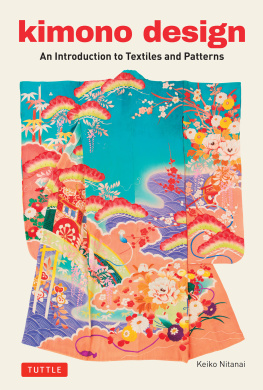
Selling the Kimono
Based on twelve months of in-depth ethnographic research in Japan with retailers, customers, wholesalers, writers and craftspeople, Selling the Kimono is a journey behind the scenes of a struggle to adapt to difficult economic conditions and declining demand for the kimono.
The kimono is an iconic piece of clothing, instantly recognised as a symbol of traditional Japanese culture. Yet, little is known about the industry that makes and sells the kimono, in particular the crisis this industry is currently facing. Since the 1970s, kimono sales have dropped dramatically, craftspeople are struggling to find apprentices, and some retailers have closed up shop.
Illuminating recent academic investigations into the lived experience of economic crisis, this volume presents a story of an industry in crisis, and the narratives of hope, creativity and resilience that have emerged in response. The ethnographic depth and theoretical contribution to understanding the effects of economic crisis and the transformation of traditional culture will be of broad interest to students, academics and the general public.
Julie Valk is a Postdoctoral Research Associate at Kings College London. She is a social anthropologist who has produced a substantial body of work on the Japanese kimono industry and contemporary kimono culture. Her work has appeared in HAU: the Journal of Ethnographic Theory (2020), the Journal of Material Culture (2020) and Fashion Theory (2018). She has research interests in economic anthropology, the sociology of expertise, financial systems, Japanese society and culture, as well as clothing and fashion.
Routledge Advances in Ethnography
Edited by Dick Hobbs, University of Essex and Les Back, Goldsmiths, University of London
Ethnography is a celebrated, if contested, research methodology that offers unprecedented access to people's intimate lives, their often hidden social worlds and the meanings they attach to these. The intensity of ethnographic fieldwork often makes considerable personal and emotional demands on the researcher, while the final product is a vivid human document with personal resonance impossible to recreate by the application of any other social science methodology. This series aims to highlight the best, most innovative ethnographic work available from both new and established scholars.
Migrant City
Les Back and Shamser Sinha
The Logic of Violence
An Ethnography of Dublin's Illegal Drug Trade
Brendan Marsh
Black Men in Britain
An Ethnographic Portrait of the Post-Windrush Generation
Kenny Monrose
Moving Difference
Brazilians in London
Angelo Martins Junior
Selling the Kimono
An Ethnography of Crisis, Creativity and Hope
Julie Valk
For more information about series page, please visit https://www.routledge.com/Routledge-Advances-in-Ethnography/book-series/RETH
Selling the Kimono
An Ethnography of Crisis, Creativity and Hope
Julie Valk
First published 2021
by Routledge
2 Park Square, Milton Park, Abingdon, Oxon OX14 4RN
and by Routledge
605 Third Avenue, New York, NY 10158
Routledge is an imprint of the Taylor & Francis Group, an informa business
2021 Julie Valk
The right of Julie Valk to be identified as author of this work has been asserted by her in accordance with sections 77 and 78 of the Copyright, Designs and Patents Act 1988.
All rights reserved. No part of this book may be reprinted or reproduced or utilised in any form or by any electronic, mechanical, or other means, now known or hereafter invented, including photocopying and recording, or in any information storage or retrieval system, without permission in writing from the publishers.
Trademark notice: Product or corporate names may be trademarks or registered trademarks, and are used only for identification and explanation without intent to infringe.
British Library Cataloguing-in-Publication Data
A catalogue record for this book is available from the British Library
Library of Congress Cataloging-in-Publication Data
A catalog record has been requested for this book
ISBN: 978-0-367-48213-8 (hbk)
ISBN: 978-0-367-49498-8 (pbk)
ISBN: 978-1-003-03869-6 (ebk)
Typeset in Times New Roman
by Newgen Publishing UK
This book is dedicated to my wonderful mother, Jennifer Griffith, for all her love and support.
Contents
All photos, maps and diagrams are the work of the author unless otherwise stated.
The simplest way to address the question of where this idea for this book came from would be to say that it is based on my doctoral fieldwork, conducted over the course of twelve months in 2015 and 2016, and my thesis. But this book is, in fact, the product of a long process of reformulation of that original fieldwork. Above all else, this book is the result of long-lasting collaborative relationships with a wide range of retailers, designers, producers, wholesalers and customers in the Japanese kimono industry.
My first experience of wearing a kimono was in 2008. In my very early 20s at the time, I was studying Japanese at Nanzan University, and I was living with my host family in Toyota the same family who would welcome me back to live with them during my doctoral research seven years later. My host mother, Sachiko, had welcomed countless foreign female students from Nanzan, and she dressed each one in a kimono. A lifelong tea ceremony practitioner and kimono aficionado, this was one of her favourite ways of having her guest experience Japanese culture. For me, however, this was a formative moment. Never had I experienced a form of dress so complex and time-consuming, and so different from what I was used to. It would be some years before I was to undertake serious research into the kimono, but that moment stayed with me.
I first stepped into a kimono shop in 2012, when I returned to Japan and worked in Kanazawa for two years. From my initial fascination with the kimono itself, I became curious about the industry. Who makes the kimono? Who sells the kimono? How well is the industry doing? Kimono retail appeared to be a world that was both part of Japans capitalist economy and, at the same time, one step removed from it, with its own conventions, structure and rules. It is a world largely unknown, especially outside of Japan, but even within the archipelago, where relatively few people get to see the inner workings of the industry. And it is an industry facing significant difficulties: deeply impacted by the economic crisis of the 1990s, it has been facing a steady decline in sales and revenue.
As this book explores in detail, by the late 20th century the formal kimono had become the standard form for Japans national dress. However, at the same time, demand for it was falling as Western clothing became more and more accepted for ceremonial and ritual occasions such as weddings, funerals and graduation ceremonies. As a result, the business model of the industry based on formal kimono was therefore less and less lucrative. And yet, what really struck me and ultimately motivated me to write this book was the resilience and creativity of those in the industry, and their capacity to hope in the face of crisis. My doctoral thesis focused, for the most part, on the transition from formal kimono to fashion kimono in the late 20th and early 21st century, exploring the socio-economic and cultural reasons for this shift: the 1990s economic crisis significantly impacted disposable incomes and spending practices, just as attitudes changed towards ritual life in Japan and the appropriate attire for ritual life. But in the two years following the completion of my thesis, and in my continued conversations with my research participants, I reflected more deeply on the mechanisms behind these changes, beyond their immediate socio-economic and cultural causes. It appeared to me that there was an apparently paradoxical relationship between economic crisis and hope, and that this complicated relationship has spurred the creativity with which a section of the kimono industry has reinvented its business model and carved out new markets.












